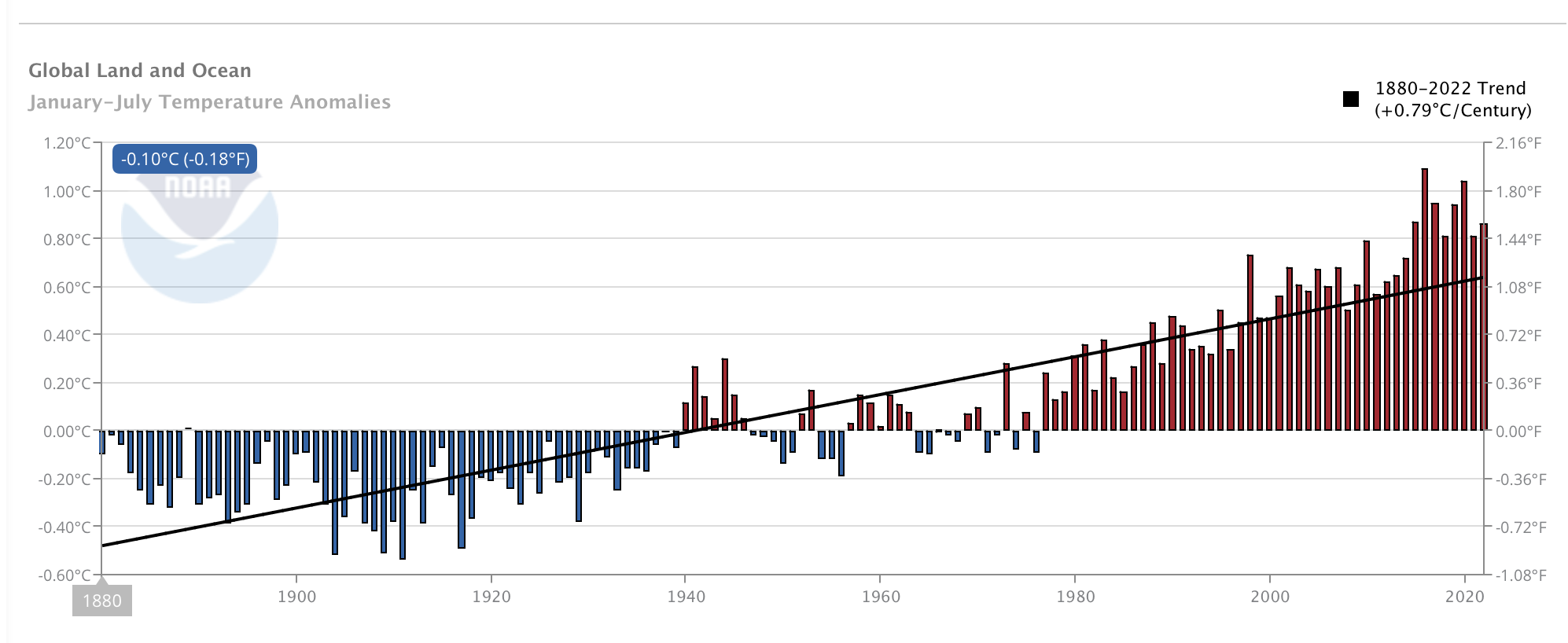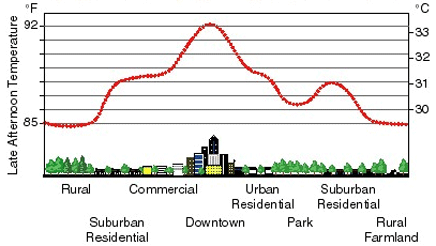Status and Trends of Global Temperatures Since 1880 (Click Here for Latest Year)
(Source: NOAA National Climatic Data Center)
From NOAA - The combined global land and ocean average surface temperature for July 2022 was one of the warmest on record. The long term trend is +0.79 deg C per Century.

From Japan - Status and Trends of Global Temperatures Since 1895 - Latest Available
Source: Japan Meteorological Agency

Analysis: The projected temperature rise by IPCC is unrealistic, given that the USA and global temperatures have risen by only 1.3 deg F (.7 C) in 100 years, (or 150 years using the full instrumented data set) during the height of industrial expansion. As can be seen in the above chart, which includes the latest data, the trend line is 0.72 deg. C per century. Even if all this rise is correct, and is attributable to human causes, it is a small amount in the natural variation of the Earth, and to suggest the rise would accelerate 5 fold (IPCC best estimate) in this century is hard to believe. Even after the release of the new data set and procedures by NOAA, which addressed some of the urban heat island issues and dropped the warming 44% (below IPCC 2007), significant other urban heat island issues still remain. There are also issues of calibration as measurement protocols have changed, issues about the design and placement of the temperature stations, and even the strongly held view by many skeptics that this is a natural rise as the Earth recovers from the Little Ice Age (circa 1500-1900)
If the city where you live has a higher temperature than its suburbs, you can imagine the impact of growth around the world on land-based temperatures. The USA has fixed many of these problems.
The table below summarises some of the differences in various weather elements in urban areas compared with rural locations (Source: British Met Office).
| Sunshine duration | 5 to 15% less |
| Annual mean temperature | 0.5-1.0 °C higher |
Winter maximum temperatures |
1 to 2 °C higher |
| Occurrence of frosts | 2 to 3 weeks fewer |
| Relative humidity in winter | 2% lower |
Relative humidity in summer |
8 to 10% lower |
Total precipitation |
5 to 10% more |
| Number of rain days | 10% more |
| Number of days with snow | 14% fewer |
| Cloud cover | 5 to 10% more |
| Occurrence of fog in winter | 100% more |
Amount of condensation nuclei |
10 times more |
The formation of a heat island is the result of the interaction of the following factors:
-
the release (and reflection) of heat from industrial and domestic buildings;
-
the absorption by concrete, brick and tarmac of heat during the day, and its release into the lower atmosphere at night;
-
the reflection of solar radiation by glass buildings and windows. The central business districts of some urban areas can therefore have quite high albedo rates (proportion of light reflected);
-
the emission of hygroscopic pollutants from cars and heavy industry act as condensation nuclei, leading to the formation of cloud and smog, which can trap radiation. In some cases, a pollution dome can also build up;
-
recent research on London's heat island has shown that the pollution domes can also filter incoming solar radiation, thereby reducing the build up of heat during the day. At night, the dome may trap some of the heat from the day, so these domes might be reducing the sharp differences between urban and rural areas;
-
the relative absence of water in urban areas means that less energy is used for evapotranspiration and more is available to heat the lower atmosphere;
-
the absence of strong winds to both disperse the heat and bring in cooler air from rural and suburban areas. Indeed, urban heat islands are often most clearly defined on calm summer evenings, often under blocking anticyclones.
The precise nature of the heat island varies from urban area to urban area, and it depends on the presence of large areas of open space, rivers, the distribution of industries and the density and height of buildings. In general, the temperatures are highest in the central areas and gradually decline towards the suburbs. In some cities, a temperature cliff occurs on the edge of town. This can be clearly seen on the heat profile below for Chester.

Urban heat island in Chester
The Urban Heat Island (UHI) describes the increased temperature of urban air compared to the rural surroundings. The term ‘heat island’ is used because warmer city air lies in a ‘sea’ of cooler rural air.
The figure below shows a stylised heat island profile for a city, showing temperatures rising from the rural fringe and peaking in the city centre. The profile also demonstrates how temperatures can vary across a city depending on the nature of the land cover, such that urban parks and lakes are cooler than adjacent areas covered by buildings.

Sketch of an urban heat island
Source of chart and text: The Met Office
The higher urban temperatures are caused by the increased capacity of the urban land surface (eg. roads, buildings, pavements) to absorb and trap heat.
This results in towns and cities remaining noticeably hotter than the surrounding countryside, particularly at night on calm, clear summer nights. The UHI can add 5-6°C to the nighttime temperatures experienced. During the summer heatwave of 2003, differences of up to 9°C between city and rural temperatures were measured in London.